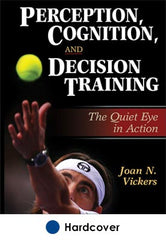Explanation of the three-step decision training model
This is an excerpt from Perception, Cognition, and Decision Training:The Quiet Eye in Act by Joan Vickers.
We saw in the previous section that one of the main reasons that the decision-training approach has been successful is because of a curious paradox that has occurred in the research on motor learning in the past few years. This paradox shows that the traditional approaches to sport training, with their high levels of repetition, feedback, and direct instruction, lead to impressive gains in the short term, but athletes trained exclusively under these conditions often falter in the long term. Research on motor learning now advocates the use of new methods, such as variable practice, random practice, and bandwidth feedback. However, these methods, which are decision-training tools, are not enough to ensure successful performance. Instead, the overall purpose of the practice must be defined first and stated clearly. In the past, instructional designers, curriculum leaders, coaches, and teachers were taught to identify the behavioral goals they wanted their athletes to achieve. Decision training does not follow this approach, but instead requires that the critical athlete decisions underlying successful performance be defined and overtly trained within the practice training environment. The goal is to help the athlete make better decisions, which in turn will lead to greater long term gains in performance.
Instead of leaving to chance the tough job of learning how to make effective decisions, the three steps of the decision-training model bring the training of critical decisions found in each sport to the fore. Figure 9.2 presents the three steps of the decision-training model.
More Excerpts From Perception


Get the latest insights with regular newsletters, plus periodic product information and special insider offers.
JOIN NOW


